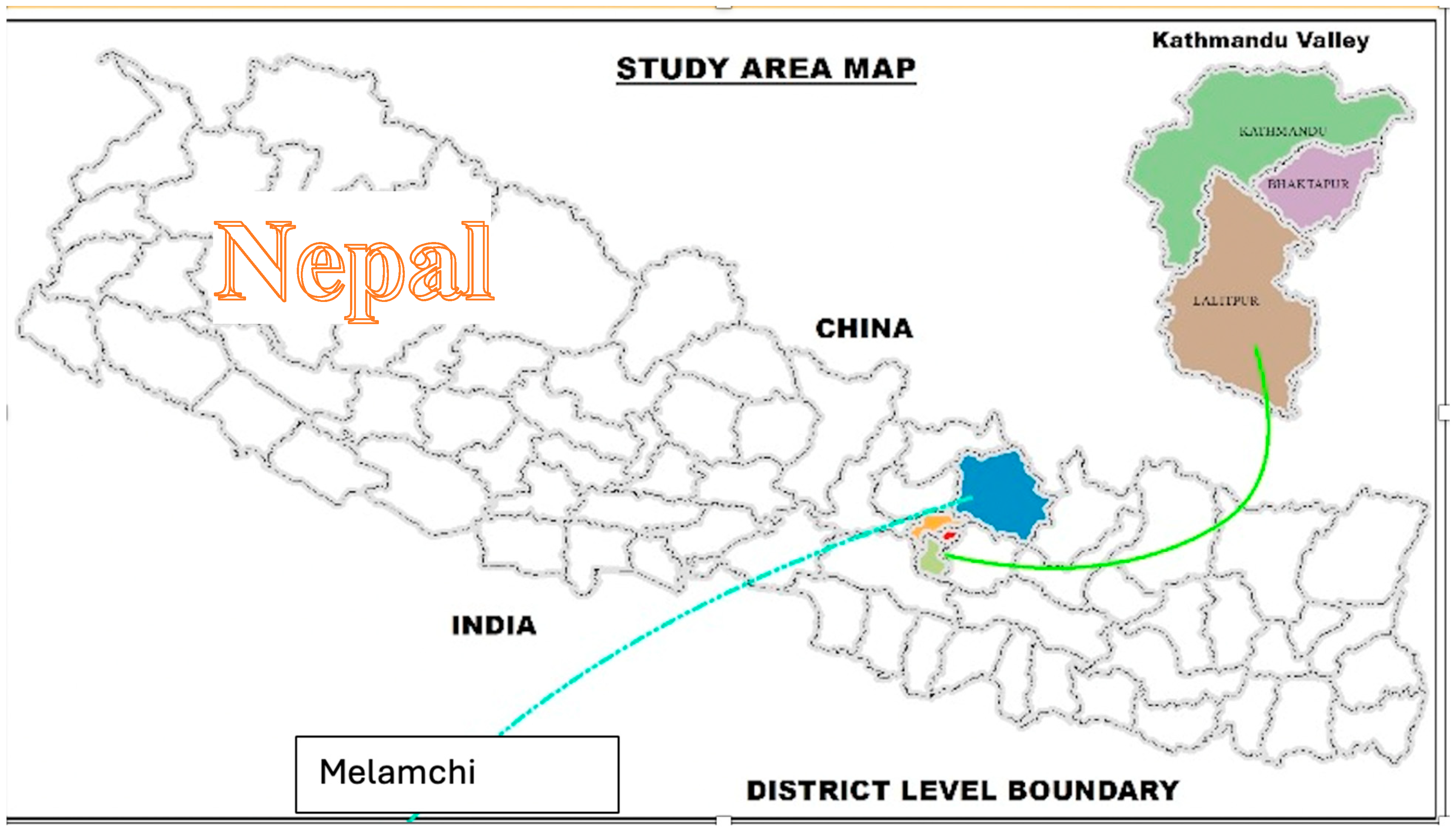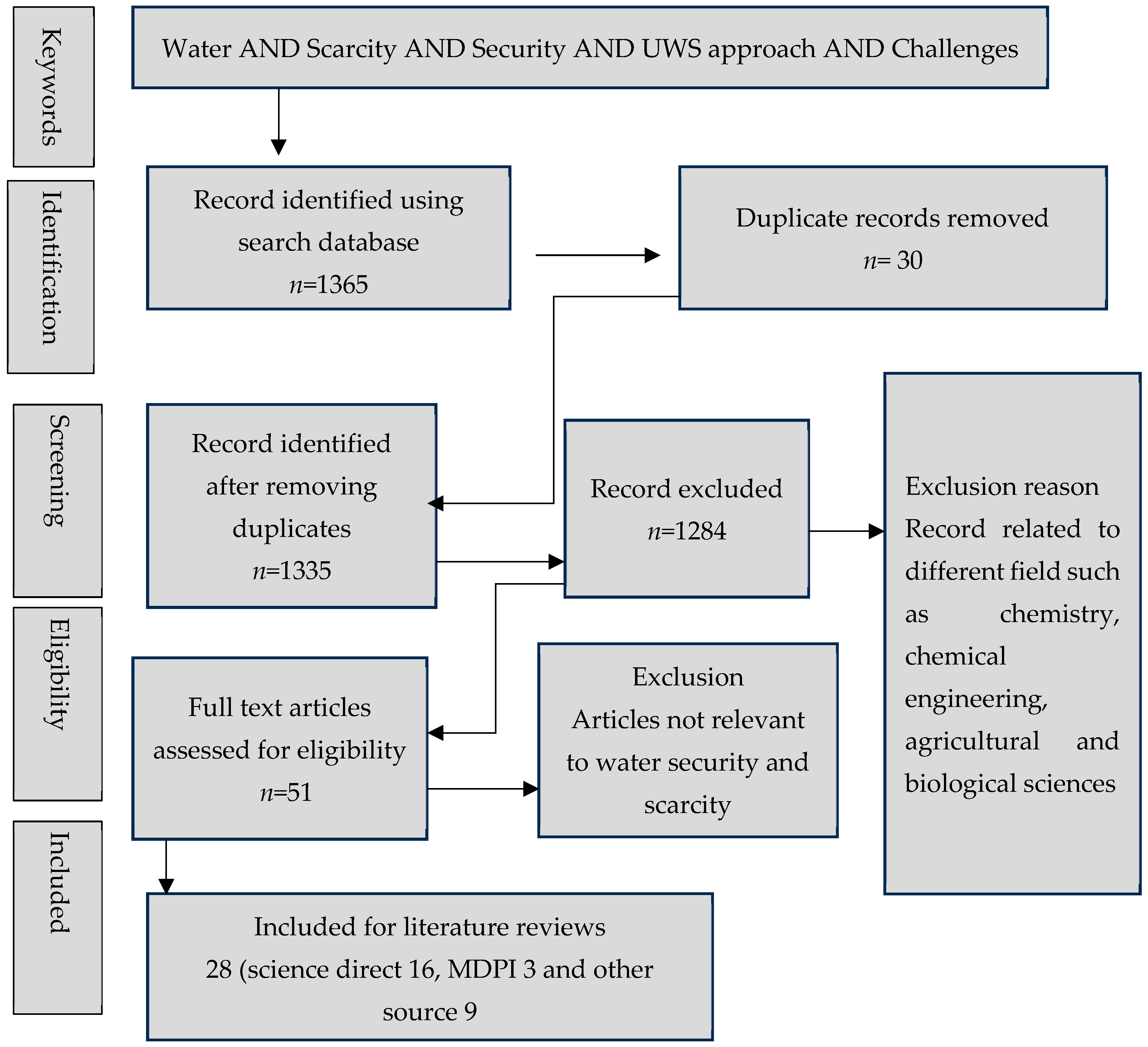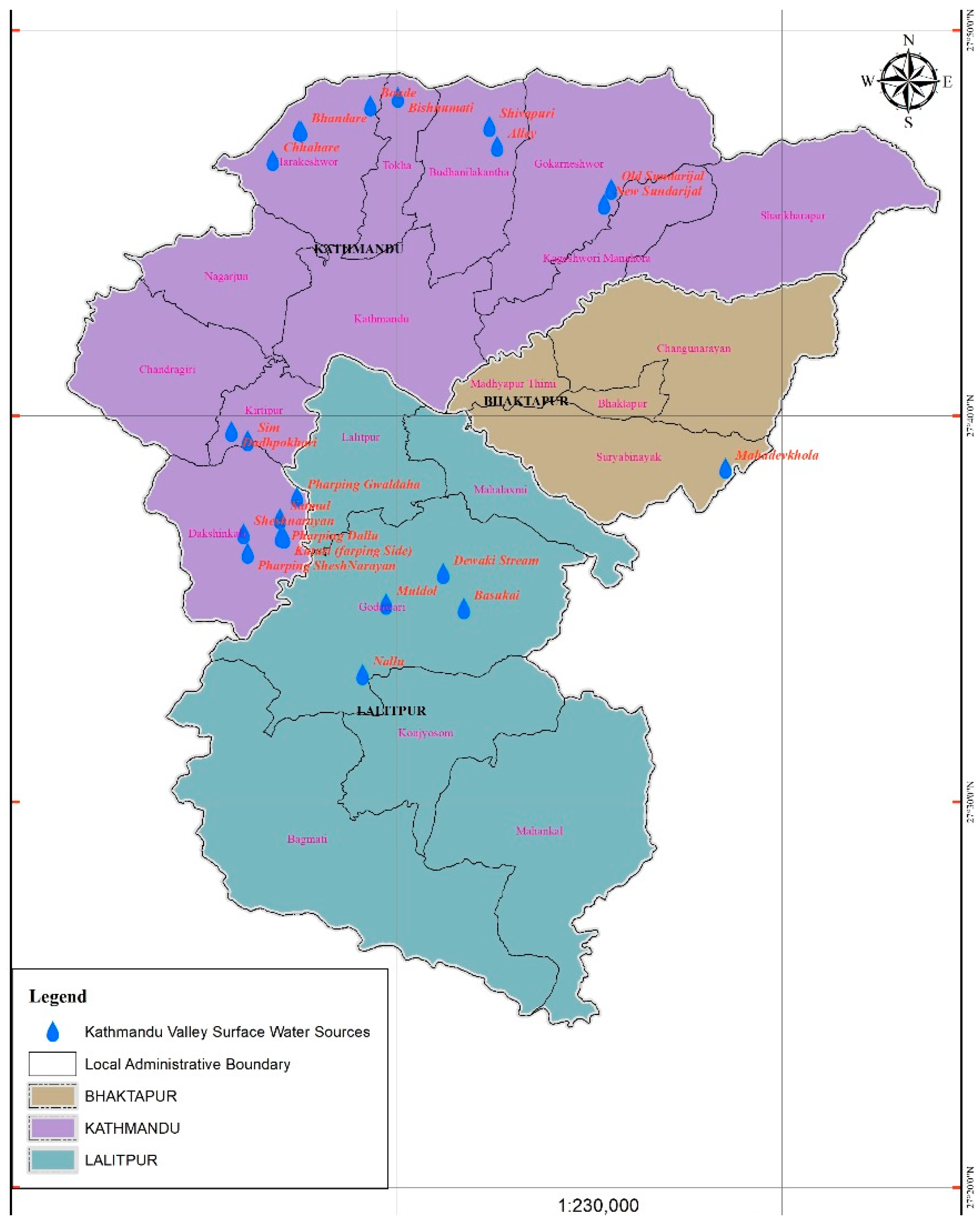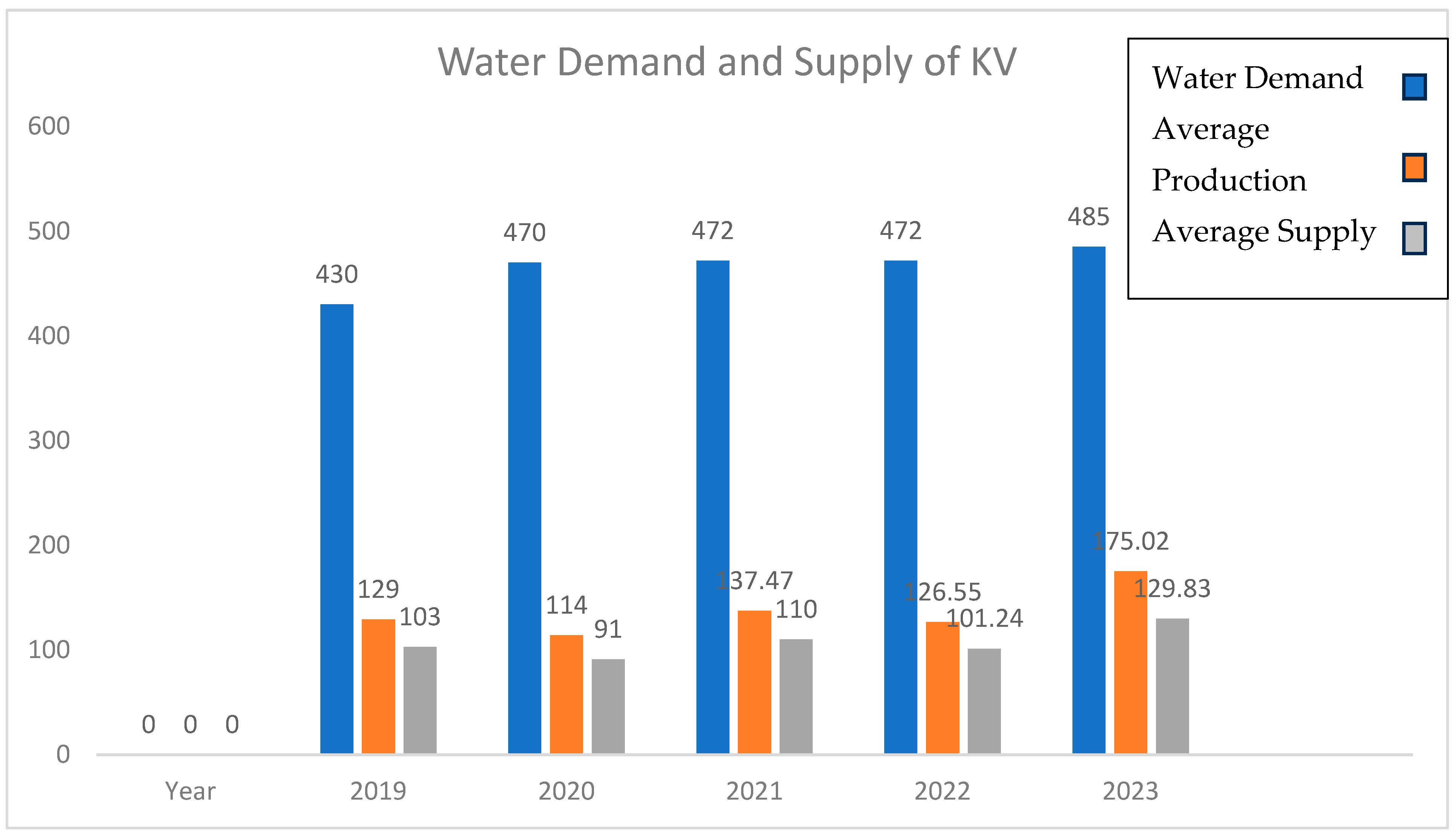Challenges of Urban Water Security and Drivers of Water Scarcity in Kathmandu Valley, Nepal
Abstract
1. Introduction
2. Study Area Description
3. Literature Reviews
4. Methods
5. Result
5.1. Water Systems of Kathmandu Valley
5.2. Analysis of Water Resources, Quantity, and Quality
5.2.1. Water Resources
5.2.2. Quantity of Water
5.2.3. Quality of Water
5.3. Interview Results on Drivers of Water Scarcity
5.3.1. Pollution
5.3.2. Urbanization
5.3.3. Management
5.3.4. Investment
5.4. Water Resource Security, Water Environment Security, and Water Disaster Security
6. Discussion
7. Conclusions
Author Contributions
Funding
Data Availability Statement
Acknowledgments
Conflicts of Interest
References
- UNESCO. International Hydrological Programme (IHP) Eighth Phase: Water Security: Responses to Local, Regional and Global Challenges, Strategic Plan, IHP-VIII (2014–2021) (IHP/2012/IHP-VIII/1 REV). United Nations Educational, Scientific and Cultural Organization. 2012. Available online: https://unesdoc.unesco.org/ark:/48223/pf0000218061/ (accessed on 4 June 2024).
- UNESO; UNESCO i-WSSM. Water Security and the Sustainable Development Goals (Series 1). 2019. Available online: https://unesco-iwssm.org/ (accessed on 4 June 2024).
- UN-Water. Summary Progress Update 2021: SDG 6-Water and Sanitation for All. 2021. Available online: https://www.unwater.org/sites/default/files/app/uploads/2021/12/SDG-6-Summary-Progress-Update-2021_Version-July-2021a.pdf (accessed on 4 June 2024).
- WHO. WHO Drinking Water. Available online: https://www.who.int/news-room/fact-sheets/detail/drinking-water (accessed on 7 June 2024).
- WHO. Financing Universal Water, Sanitation and Hygiene Under the Sustainable Development Goals: UN-Water Global Analysis and Assessment of Sanitation and Drinking-Water: GLAAS 2017 Report. 2017. Available online: https://iris.who.int/bitstream/handle/10665/254999/9789241512190-eng.pdf (accessed on 4 June 2024).
- UNICEF. Urban Water Scarcity Guidance Note Preventing day Zero. 2021. Available online: www.unicef.org (accessed on 4 June 2024).
- Poudyal, R. Learning from the Challenges of the Melamchi Water Supply in Kathmandu Ritu Poudyal. Available online: https://www.worldwildlife.org/threats/water-scarcity (accessed on 4 June 2024).
- JICA. Japan’s Experiences on Water Supply Development: Overview I1-i Japan’s Experiences on Water Supply Development Japan’s Experiences on Water Supply Development: Overview Contents. Available online: https://www.jica.go.jp/Resource/english/our_work/thematic_issues/water/c8h0vm0000ammj2q-att/activity_01.pdf (accessed on 4 June 2024).
- Su, Y.; Gao, W.; Guan, D.; Zuo, T. Achieving Urban Water Security: A Review of Water Management Approach from Technology Perspective; Springer Science and Business Media B.V.: Berlin/Heidelberg, Germany, 2020. [Google Scholar] [CrossRef]
- KUKL. KUKL Annual Report; Kathmandu Upatyaka Khanepani Limited: Kathmandu, Nepal, 2024; Available online: https://kathmanduwater.org/wp-content/uploads/2024/02/KUKL_Annual_Report_2080.pdf (accessed on 4 January 2025).
- MWSB. Melamchi Water Supply Board. Available online: http://www.melamchiwater.gov.np/about-us/melamchi-ws-project/project-description/ (accessed on 30 May 2024).
- Melamchi Municipality. Local Disaster and Climate Change Resilient Plan. 2019. Available online: https://melamchimun.gov.np/sites/melamchimun.gov.np/files/documents/REPORT_LDCRP_FINAL.pdf (accessed on 1 February 2025).
- Sarkar, B.; Mitchell, E.; Frisbie, S.; Grigg, L.; Adhikari, S.; Byanju, R.M. Drinking Water Quality and Public Health in the Kathmandu Valley, Nepal: Coliform Bacteria, Chemical Contaminants, and Health Status of Consumers. J. Environ. Public Health 2022, 2022, 3895859. [Google Scholar] [CrossRef] [PubMed]
- Shrestha, A.; Shah, D.N.; Bajracharya, R.M.; Shrestha, S. Traditional Stone Water Spouts Status and Its Practical Significance in Urbanizing Kathmandu Valley, Nepal—A Review. Environ. Chall. 2022, 8, 100573. [Google Scholar] [CrossRef]
- Molden, O.; Griffin, N.; Meehan, K. The cultural dimensions of household water security: The case of Kathmandu’s stone spout systems. Water Int. 2016, 41, 982–997. [Google Scholar] [CrossRef]
- Joshi, J. Preserving the Hiti, Ancient Water Spout System of Nepal. In Proceedings of the Fabric, Threads of Conservation, Australia ICOMOS Conference, Adelaide, Australia, 5–8 November 2015. [Google Scholar]
- Leveque, B.; Shyaka, A.I.; Ndong, M.; Jalbert, J.; Burnet, J.B.; Kammoun, R.; Dorner, S.; Bichai, F. Assessing the vulnerability of urban drinking water intakes to water scarcity under global change: A bottom-up approach. Environ. Chall. 2024, 15, 100885. [Google Scholar] [CrossRef]
- Huang, Z.; Yuan, X.; Liu, X. The key drivers for the changes in global water scarcity: Water withdrawal versus water availability. J. Hydrol. 2021, 601, 126658. [Google Scholar] [CrossRef]
- Ba, W.; Wang, D.; Gong, B.; Dai, Y.; Yang, Z.; Liu, Z. Urban Water Scarcity in China: A Systematic Review of Research Advances and Future Directions. Appl. Geogr. 2023, 159, 103069. [Google Scholar] [CrossRef]
- Tomar, A.; Burton, H.V.; Mosleh, A.; Lee, J.Y. Hindcasting the Functional Loss and Restoration of the Napa Water System Following the 2014 Earthquake Using Discrete-Event Simulation. J. Infrastruct. Syst. 2020, 26, 4. [Google Scholar] [CrossRef]
- Mishra, V.; Aaadhar, S.; Shah, H.; Kumar, R.; Pattanaik, D.R.; Tiwari, A.D. The Kerala flood of 2018: Combined impact of extreme rainfall and reservoir storage. Hydrol. Earth Syst. Sci. Discuss. 2018, 2018, 1–13. [Google Scholar] [CrossRef]
- McPherson, M.; Counahan, M.; Hall, J.L. Responding to Typhoon Haiyan in the Philippines. West. Pac. Surveill. Response J. WPSAR 2015, 6 (Suppl. S1), 1. [Google Scholar] [CrossRef]
- Nepal Post Disaster Needs Assessment. Nepal Earthquake 2015; Post Disaster Needs Assessment; National Planning Commission: Kathmandu, Nepal, 2015.
- Klise, K.; Regan, M.; Terranna, H. An Overview of the Water Network Tool for Resilience (WNTR). 2018. Available online: https://github.com/USEPA/WNTR (accessed on 30 May 2024).
- Bogardi, J.J.; Dudgeon, D.; Lawford, R.; Flinkerbusch, E.; Meyn, A.; Pahl-Wostl, C.; Vielhauer, K.; Vörösmarty, C. Water security for a planet under pressure: Interconnected challenges of a changing world call for sustainable solutions. Curr. Opin. Environ. Sustain. 2012, 4, 35–43. [Google Scholar] [CrossRef]
- Yang, Y.; Tatano, H.; Huang, Q.; Liu, H.; Yoshizawa, G.; Wang, K. Evaluating the societal impact of disaster-driven infrastructure disruptions: A water analysis perspective. Int. J. Disaster Risk Reduct. 2021, 52, 101988. [Google Scholar] [CrossRef]
- Quitana, G.; Molinos-Senante, M.; Chamorro, A. Resilience of Critical Infrastructure to Natural Hazards: A Review Focused on Drinking Water Systems. Int. J. Disaster Risk Reduct. 2020, 48, 101575. [Google Scholar] [CrossRef]
- Raza, T.; Shehzad, M.; Qadir, M.F.; Kareem, H.A.; Eash, N.S.; Sillanpaa, M.; Hakeem, K.R. Indirect effects of Covid-19 on water quality. Water-Energy Nexus 2022, 5, 29–38. [Google Scholar] [CrossRef]
- van Steenbergen, F.; Kaisarani, A.B.; Khan, N.U.; Gohar, M.S. A case of groundwater depletion in Balochistan, Pakistan: Enter into the void. J. Hydrol. Reg. Stud. 2015, 4, 36–47. [Google Scholar] [CrossRef]
- Balaei, B.; Wilkinson, S.; Potangaroa, R.; Adamson, C.; Alavi-Shoshtari, M. Social factors affecting water supply resilience to disasters. Int. J. Disaster Risk Reduct. 2019, 37, 101187. [Google Scholar] [CrossRef]
- Sukhwani, V.; Thapa, K.; Shaw, R.; Deshkar, S.; Mitra, B.K.; Yan, W. Addressing urban–rural water conflicts in nagpur through benefit sharing. Water 2020, 12, 2979. [Google Scholar] [CrossRef]
- Zhang, W.; Liang, W.; Gao, X.; Li, J.; Zhao, X. Trajectory in water scarcity and potential water savings benefits in the Yellow River basin. J. Hydrol. 2024, 633, 130998. [Google Scholar] [CrossRef]
- Gong, B.; Liu, Z.; Liu, Y.; Zhou, S. Understanding advances and challenges of urban water security and sustainability in China based on water footprint dynamics. Ecol. Indic. 2023, 150, 110233. [Google Scholar] [CrossRef]
- Lazaro, L.L.B.; Abram, S.; Giatti, L.L.; Sinisgalli, P.; Jacobi, P.R. Assessing water scarcity narratives in Brazil–Challenges for urban governance. Environ. Dev. 2023, 47, 100885. [Google Scholar] [CrossRef]
- Galaitsi, S.E.; Russell, R.; Bishara, A.; Durant, J.L.; Bogle, J.; Huber-Lee, A. Intermittent domestic water supply: A critical review and analysis of causal-consequential pathways. Water 2016, 8, 274. [Google Scholar] [CrossRef]
- Thapa, B.R.; Ishidaira, H.; Pandey, V.P.; Shakya, N.M. A multi-model approach for analyzing water balance dynamics in Kathmandu Valley, Nepal. J. Hydrol. Reg. Stud. 2017, 9, 149–162. [Google Scholar] [CrossRef]
- Awale, S.; Uprety, S. Assessing Hiti System as a Nature Based Solution in Addressing Water Security in Kathmandu Valley. 2023. Available online: https://conference.ioe.edu.np/publications/ioegc14/IOEGC-14-081-E2-6-286.pdf (accessed on 1 January 2025).
- Maharjan, A. Traditional Stone Spouts in Newar Community: Interpretive Inquiry. 2022. Available online: https://elibrary.ku.edu.np/bitstream/20.500.14301/105/1/Alisha%20Maharjan.pdf (accessed on 1 January 2025).
- Upadhyay, S.; Thapa, A.B.; Prajapati, R. The Status of Traditional Stone Spouts in the Kathmandu Valley NepalT. 2019. Available online: https://old.kecnepal.com/wp-content/uploads/2020/01/Paper_34.pdf (accessed on 1 January 2025).
- Shakya, B.M.; Nakamura, T.; Shrestha, S.; Pathak, S.; Nishida, K.; Malla, R. Tap Water Quality Degradation in an Intermittent Water Supply Area. Water Air Soil Pollut. 2022, 233, 3. [Google Scholar] [CrossRef]
- Amarasiri, M.; Takezawa, T.; Malla, B.; Furukawa, T.; Sherchand, J.B.; Haramoto, E.; Sei, K. Prevalence of antibiotic resistance genes in drinking and environmental water sources of the Kathmandu Valley, Nepal. Front. Microbiol. 2022, 13, 894014. [Google Scholar] [CrossRef]
- Acharya, S.; Hori, T.; Karki, S. Assessing the spatio-temporal impact of landuse landcover change on water yield dynamics of rapidly urbanizing Kathmandu valley watershed of Nepal. J. Hydrol. Reg. Stud. 2023, 50, 101562. [Google Scholar] [CrossRef]
- Udmale, P.; Ishidaira, H.; Thapa, B.R.; Shakya, N.M. The status of domestic water demand: Supply deficit in the Kathmandu Valley, Nepal. Water 2016, 8, 196. [Google Scholar] [CrossRef]
- Census, National Population and Housing Census 2021 Volume 01 National Report. 2021. Available online: https://censusnepal.cbs.gov.np/results/files/result-folder/National%20Report_English.pdf (accessed on 1 January 2025).
- KUKL. About Us. Available online: https://kathmanduwater.org/index.php/about-us/ (accessed on 1 January 2025).
- ADB. Mapping Hazards in Nepal’s Melamchi River: Catchment to Enhance Kathmandu’s Water Security. 2023. Available online: https://www.adb.org/sites/default/files/publication/927371/mapping-hazards-nepal-melamchi-river.pdf (accessed on 4 June 2024).
- Shrestha, S.; Aihara, Y.; Bhattarai, A.P.; Bista, N.; Kondo, N.; Futaba, K.; Nishida, K.; Shindo, J. Development of an objective water security index and assessment of its association with quality of life in urban areas of developing countries. SSM Popul. Health 2018, 6, 276–285. [Google Scholar] [CrossRef]
- Shrestha, S.; Neupane, S.; Mohanasundaram, S.; Pandey, V.P. Mapping groundwater resiliency under climate change scenarios: A case study of Kathmandu Valley, Nepal. Environ. Res. 2020, 183, 109149. [Google Scholar] [CrossRef]
- GoN. brbip.gov.np. Available online: https://brbip.gov.np/project-rationale.php (accessed on 4 July 2024).
- KUKLPID. Kathmandu Valley Water Supply Improvement Project Under Loan-3255 AF Will Support On-Going Efforts of Government of Nepal Towards. Available online: https://kuklpid.org.np/Projects/ProjectsDetails/KVWMP_ADB_LOAN-3255_NEP_SF (accessed on 4 July 2024).
- UN-Habitat. Urban-Rural Linkages Compendium of Case Studies for the Implementation of the Guiding Principles of Urban-Rural Link-Ages and Framework for Action. 2020. Available online: https://unhabitat.org/sites/default/files/2020/06/compendium-of-url-case-studies_web-vers_.pdf (accessed on 1 July 2024).
- Edmonds-Brown, V. Academic Rigour, Journalistic Flair. 2022. Available online: https://theconversation.com/from-biologically-dead-to-chart-toppingly-clean-how-the-thames-made-an-extraordinary-recovery-over-60-years-180895#:~:text=F (accessed on 1 January 2025).
- GoN. Nepal Disaster Report 2017—The Road to Sendai Ministry of Home Affairs. 2017. Available online: https://www.dpnet.org.np/uploads/files/Nepal%20Disaster%20Report,%202017%202019-04-01%2009-52-10.pdf (accessed on 18 January 2024).
- KUKL. KUKL Annual Report; Kathmandu Upatyaka Khanepani Limited: Kathmandu, Nepal, 2023; Available online: https://kathmanduwater.org/wp-content/uploads/2024/02/KUKL_Annual_Report_2080.pdf (accessed on 18 July 2024).
- Popovska, C.; Jovanovski, M.; Sekovski, D. Build Back Better Approach to Recovery of Flood-Damaged Transport and Water Infrastructure. In Proceedings of the Water Management and Hydraulic Engineering, Skopje, Macedonia, 5–7 September 2019. [Google Scholar]
- Gerlak, A.K.; Varady, R.G.; Petit, O.; Haverland, A.C. Hydrosolidarity and beyond: Can ethics and equity find a place in today’s water resource management? Water Int. 2011, 36, 251–265. [Google Scholar] [CrossRef]
- Gerlak, A.K.; Varady, R.G.; Haverland, A.C. Hydrosolidarity and international water governance. Int. Negot. 2009, 14, 311–328. [Google Scholar] [CrossRef]
- Ross, A.G.; Connolly, K.; Vögele, S.; Kuckshinrichs, W. A macro-level analysis of the socio-economic impacts of climate change driven water scarcity: Incorporating behavioral and resilience aspects. Water Res. X 2024, 23, 100223. [Google Scholar] [CrossRef]
- Arenas-Sánchez, A.; Rico, A.; Vighi, M. Effects of water scarcity and chemical pollution in aquatic ecosystems: State of the art. Sci. Total Environ. 2016, 572, 390–403. [Google Scholar] [CrossRef] [PubMed]
- Dosi, C.; Easter, K.W. Water Scarcity: Institutional Change, Water Markets, and Privatization. In Economic Studies on Food, Agriculture, and the Environment; Springer: New York, NY, USA, 2002; pp. 91–115. [Google Scholar] [CrossRef]
- Macchiaroli, M.; Dolores, L.; De Mare, G. Design the Water Tariff Structure: Application and Assessment of a Model to Balance Sustainability, Cost Recovery and Wise Use. Water 2023, 15, 1309. [Google Scholar] [CrossRef]





Disclaimer/Publisher’s Note: The statements, opinions and data contained in all publications are solely those of the individual author(s) and contributor(s) and not of MDPI and/or the editor(s). MDPI and/or the editor(s) disclaim responsibility for any injury to people or property resulting from any ideas, methods, instructions or products referred to in the content. |
© 2025 by the authors. Licensee MDPI, Basel, Switzerland. This article is an open access article distributed under the terms and conditions of the Creative Commons Attribution (CC BY) license (https://creativecommons.org/licenses/by/4.0/).
Share and Cite
Poudel, N.; Shaw, R. Challenges of Urban Water Security and Drivers of Water Scarcity in Kathmandu Valley, Nepal. Urban Sci. 2025, 9, 54. https://doi.org/10.3390/urbansci9030054
Poudel N, Shaw R. Challenges of Urban Water Security and Drivers of Water Scarcity in Kathmandu Valley, Nepal. Urban Science. 2025; 9(3):54. https://doi.org/10.3390/urbansci9030054
Chicago/Turabian StylePoudel, Namita, and Rajib Shaw. 2025. "Challenges of Urban Water Security and Drivers of Water Scarcity in Kathmandu Valley, Nepal" Urban Science 9, no. 3: 54. https://doi.org/10.3390/urbansci9030054
APA StylePoudel, N., & Shaw, R. (2025). Challenges of Urban Water Security and Drivers of Water Scarcity in Kathmandu Valley, Nepal. Urban Science, 9(3), 54. https://doi.org/10.3390/urbansci9030054






